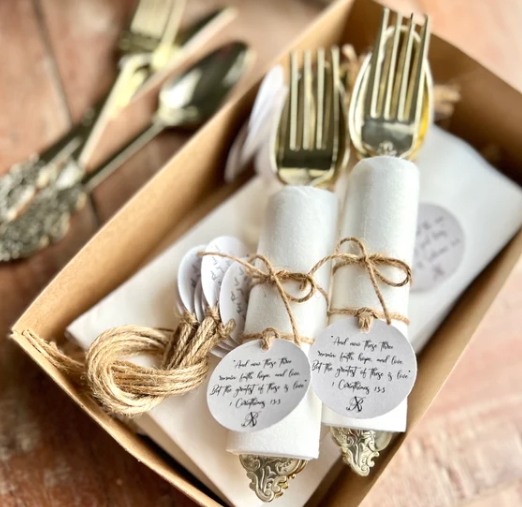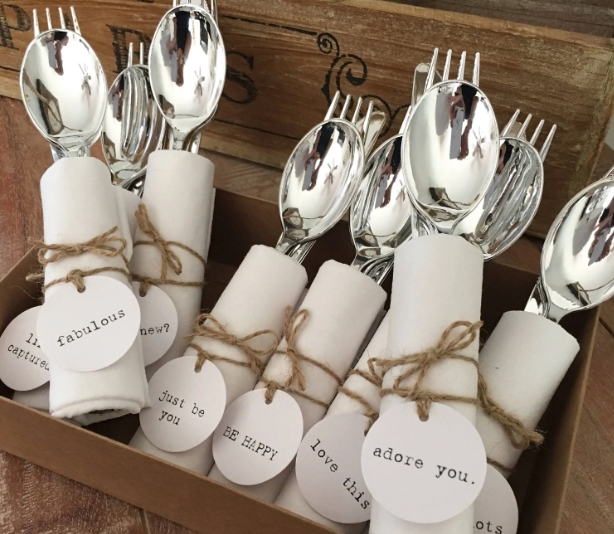
Content Menu
● What Is Nice Disposable Cutlery?
● Why Choose Nice Disposable Cutlery?
>> Environmental Benefits
>> Practical Advantages
● Types of Nice Disposable Cutlery and Their Environmental Impact
>> Wooden Cutlery
>> Bamboo Cutlery
>> Plant Fibre Cutlery
>> Palm Leaf Cutlery
>> Paper Cutlery
● Environmental Impact Compared to Plastic Cutlery
● Challenges and Considerations
● Future Trends in Nice Disposable Cutlery
● Conclusion
● FAQ
>> 1. What materials are used to make nice disposable cutlery?
>> 2. How long does nice disposable cutlery take to decompose?
>> 3. Is nice disposable cutlery strong enough for hot or heavy foods?
>> 4. Can nice disposable cutlery be recycled?
>> 5. Is nice disposable cutlery more expensive than plastic cutlery?
● Citations:
In recent years, the environmental impact of single-use plastics has come under intense scrutiny, prompting consumers and businesses alike to seek sustainable alternatives. Among these, nice disposable cutlery has emerged as a popular choice, touted for its convenience and eco-friendliness. But how environmentally friendly is nice disposable cutlery really? This comprehensive article explores the materials, benefits, drawbacks, and future of nice disposable cutlery, with a focus on its sustainability credentials.

What Is Nice Disposable Cutlery?
Nice disposable cutlery refers to single-use eating utensils designed to be both functional and environmentally conscious. Unlike traditional plastic cutlery, which is petroleum-based and non-biodegradable, nice disposable cutlery is typically made from renewable, biodegradable materials such as bamboo, wood, plant fibers, or palm leaves. These materials are chosen to reduce environmental harm by decomposing naturally after use, minimizing landfill waste and pollution.
The term "nice" in this context often implies that the cutlery is not only disposable but also aesthetically pleasing, durable, and eco-friendly, making it suitable for events, catering, and everyday use without the guilt associated with plastic waste.
Why Choose Nice Disposable Cutlery?
Environmental Benefits
- Biodegradability and Compostability: Unlike plastic utensils that can take hundreds of years to break down, nice disposable cutlery made from natural materials decomposes quickly in composting environments, often within weeks to months, returning nutrients to the soil without toxic residues[1][2].
- Renewable Resources: Materials such as bamboo, wood, and plant fibers come from fast-growing, renewable sources. Bamboo, for example, can grow up to 35 inches per day, making it a highly sustainable resource[1].
- Reduction of Plastic Pollution: Plastic cutlery contributes significantly to global plastic waste, including microplastic pollution in oceans that harms marine life and human health. By switching to biodegradable nice disposable cutlery, the volume of plastic waste can be substantially reduced[1].
Practical Advantages
- Durability and Aesthetic Appeal: Nice disposable cutlery is designed to be sturdy enough for various foods, including hot and heavy dishes, while also offering a natural and elegant look suitable for formal and casual settings alike[2].
- Safe and Non-Toxic: Unlike some plastic cutlery that may leach harmful chemicals, eco-friendly disposable cutlery is free from toxins, ensuring food safety, especially when handling hot or acidic foods[2].
- Versatility: These utensils are suitable for a wide range of events—from picnics to weddings—offering convenience without compromising environmental responsibility[2].
Types of Nice Disposable Cutlery and Their Environmental Impact
Wooden Cutlery
Wooden cutlery is crafted from fast-growing trees like birch and is 100% compostable. It decomposes naturally in compost heaps, typically within 6 to 12 months, leaving no toxic residue[1]. It is durable and has a timeless, natural aesthetic, making it popular for eco-conscious events.
Pros:
- Renewable and biodegradable
- Sturdy for hot and cold foods
- Low carbon footprint compared to plastic
Cons:
- Longer decomposition time than other materials
- Risk of splinters if poorly processed
Bamboo Cutlery
Bamboo is one of the most sustainable materials for disposable cutlery due to its rapid growth and carbon absorption capabilities. Bamboo cutlery biodegrades fully within 4 to 6 weeks under composting conditions[1]. It is durable, stylish, and suitable for a variety of dining needs.
Pros:
- Fast-growing and renewable
- Strong and durable
- Quick decomposition
Cons:
- Can warp under high temperatures
- Slightly higher cost than some alternatives
Plant Fibre Cutlery
Made from agricultural by-products such as sugarcane, corn starch, and wheat straw, plant fibre cutlery is compostable within about 60 days. It repurposes waste from farming, reducing overall environmental impact[1].
Pros:
- Rapid decomposition
- Utilizes agricultural waste
- Free from harmful chemicals like PFAS
Cons:
- Less durable for hard or heavy foods
- Limited availability in some markets
Palm Leaf Cutlery
Palm leaf cutlery is made from fallen Areca palm leaves, offering a natural, elegant look. It is fully biodegradable and compostable within 6 to 8 weeks[1][2].
Pros:
- Natural and toxin-free
- Durable and stylish
- Biodegradable
Cons:
- Limited availability
- Higher cost compared to other options
Paper Cutlery
Paper cutlery is an affordable and biodegradable option that decomposes rapidly, often within two weeks. It is made from pressed paper pulp and is ideal for light to moderate use[1].
Pros:
- Cost-effective
- Fast decomposition
- Low carbon footprint in production
Cons:
- Less durable, especially with hot or heavy foods
- Limited heat resistance

Environmental Impact Compared to Plastic Cutlery
Plastic disposable cutlery is a major contributor to environmental pollution, with approximately 40 billion plastic utensils discarded annually in the United States alone[1]. Plastic takes centuries to degrade and breaks down into microplastics that contaminate soil and waterways, entering the food chain and threatening ecosystems and human health.
In contrast, nice disposable cutlery made from biodegradable materials decomposes naturally without leaving harmful residues. Studies show that wooden cutlery, for example, has a carbon footprint about 73% lower than plastic cutlery[1]. Moreover, switching to biodegradable options can reduce urban plastic waste by up to 30%[1].
Challenges and Considerations
While nice disposable cutlery offers many environmental benefits, some challenges remain:
- Cost: Eco-friendly cutlery can be more expensive upfront than plastic alternatives, which may deter some consumers or businesses despite long-term benefits[2].
- Durability: Certain materials like paper and plant fiber may not be suitable for all types of food, especially heavy or hot dishes, limiting their use in some scenarios[1].
- Composting Infrastructure: The environmental benefits depend heavily on proper composting facilities being available. Without industrial composting, some biodegradable cutlery may not break down effectively in landfills.
- Resource Management: Sustainable sourcing is critical to ensure that materials like wood and bamboo come from responsibly managed forests and plantations.
Future Trends in Nice Disposable Cutlery
The market for biodegradable cutlery is growing rapidly, with an expected annual growth rate of around 12% due to increasing consumer demand for sustainable products[1]. Innovations in materials science, such as biodegradable polymers and nanotechnology, are being explored to improve durability and affordability without compromising compostability.
Companies are also focusing on circular economy principles, ensuring that products are sourced, used, and disposed of in ways that minimize waste and environmental impact[2].
Conclusion
Nice disposable cutlery represents a significant step forward in reducing the environmental footprint of single-use utensils. Made from renewable, biodegradable materials like bamboo, wood, plant fibers, and palm leaves, these utensils decompose naturally, reducing plastic pollution and landfill waste. While challenges such as cost and composting infrastructure remain, the overall benefits to the environment and human health are substantial.
Choosing nice disposable cutlery over traditional plastic cutlery not only supports sustainability but also aligns with growing consumer and regulatory demands for greener alternatives. As technology and awareness advance, nice disposable cutlery will likely become the standard for eco-friendly dining worldwide.

FAQ
1. What materials are used to make nice disposable cutlery?
Nice disposable cutlery is typically made from renewable, biodegradable materials including bamboo, wood, plant fibers (such as sugarcane and wheat straw), palm leaves, and paper pulp. These materials are chosen for their ability to decompose naturally and reduce environmental impact[1][2].
2. How long does nice disposable cutlery take to decompose?
Decomposition time varies by material:
- Bamboo: 4 to 6 weeks
- Wooden: 6 to 12 months
- Plant fiber: About 60 days
- Palm leaf: 6 to 8 weeks
- Paper: 2 to 6 weeks
These times assume proper composting conditions[1].
3. Is nice disposable cutlery strong enough for hot or heavy foods?
Materials like bamboo and wooden cutlery are generally durable enough for hot and heavy foods. Plant fiber and paper cutlery are better suited for lighter or softer foods due to lower strength and heat resistance[1][2].
4. Can nice disposable cutlery be recycled?
Most nice disposable cutlery is designed to be composted rather than recycled. Recycling facilities often do not accept biodegradable materials mixed with plastics. Composting is the preferred disposal method to ensure proper decomposition[1].
5. Is nice disposable cutlery more expensive than plastic cutlery?
Yes, eco-friendly nice disposable cutlery typically costs more upfront than plastic alternatives due to material and production costs. However, the environmental benefits and growing demand for sustainable products can offset these costs over time[2].
Citations:
[1] https://whatisgreenliving.com/best-eco-friendly-disposable-cutlery/
[2] https://prakritii.com/blogs/blog/7-reasons-why-eco-friendly-plates-and-cutlery-are-the-future-of-dining-you-can-t-ignore
[3] https://www.reddit.com/r/weddingplanning/comments/18xn55e/ecofriendly_disposables_vs_traditional_flatware/
[4] https://www.anchenggy.com/blog/best-disposable-plastic-cutlery-alternatives.html
[5] https://www.anchenggy.com/blog/the-ultimate-guide-to-biodegradable-disposable-cutlery.html
[6] https://www.biopak.com/au/cutlery-straws/cutlery
[7] https://greenpaperproducts.com/collections/compostable-cutlery
[8] https://www.ecovita.co

















